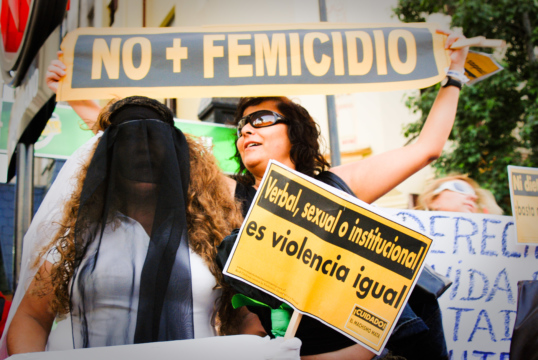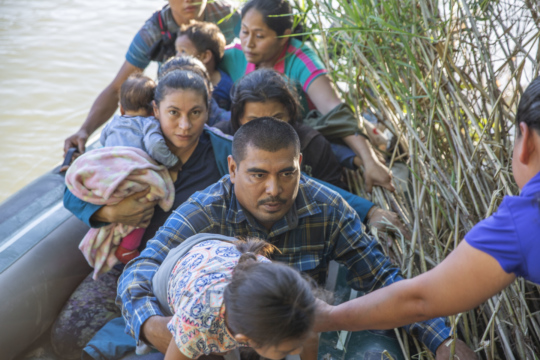As Mauricio Macri campaigned for the Argentine presidency this fall, another campaign of hundreds of thousands of individuals tirelessly fought to bring the issue of femicide, or gender-based killings of women, into Argentina’s political consciousness. These activists formed a successful movement, and their fight continues. United behind the hashtag #NiUnaMenos, or “not one less,” activists stand up for each woman’s right to life in an effort to eliminate gender-based killings in a society where a femicide takes place every thirty hours. In many of these cases, the murders are not prosecuted as femicides, as they should be under Argentine law, but rather as homicides. This is a phenomenon that takes place in numerous Latin American countries and conveniently allows states to overlook the scale and gender component of the violence. Like much of Latin America, Argentina has a long history of male chauvinism. Despite Latin America’s focus on encouraging female representation in government, machismo still informs the way of life in the region, resulting in a culture of oppression where gender violence is prolific and reproductive rights are limited. Many Latin American countries have nominally adopted well-intentioned laws protecting women’s rights, but a lack of political will has rendered the laws essentially toothless.
According to the UN Economic Commission for Latin America and the Caribbean, an estimated 1,678 women were killed for gender-based reasons in 17 Latin American and Caribbean countries in 2014. These killings take on a variety of forms. Much of the time, gender-based violence and femicide occur within couples, as well as between former partners. Femicide also includes neglect leading to death, the combined crimes of rape and murder, and “honor killings.” The global trend shows increased instances of femicide and gender-based violence in recent years, and more than half of the countries with the highest number of femicides are located in the Americas.
However, the legal mechanisms in Latin America that protect against gender-based violence and femicide are not drastically different than the legal mechanisms in the rest of the world. Femicide is a separate and punishable crime in Bolivia, Brazil, Chile, Colombia, Costa Rica, the Dominican Republic, Ecuador, El Salvador, Guatemala, Honduras, Mexico, Nicaragua, Panama, and Peru. Argentine and Venezuelan laws address the concept of “aggravated murder for gender reasons.” Additionally, 20 countries in Latin America and the Caribbean have instituted laws protecting against gender-based violence. The difference in the success of legal mechanisms is a matter of priorities. Twelve out of those 20 countries have failed to provide national funding to implement the laws, demonstrating a lack of political will. Because focusing on women’s issues does not generate votes, politicians and leaders tend to steer their platforms toward other, more popular agendas. By failing to prioritize these legal mechanisms and support related initiatives, the states greatly diminish the potential and effectiveness of the legal structures.
Reproductive rights are another area where Latin American governments’ failure to prioritize women’s rights has prevented women from accessing the protections guaranteed by their governments. In 2001, at age 17, a Peruvian minor known as K.L. learned that she was 14 weeks pregnant with a child that had been diagnosed with a fatal condition called anencephaly, which is characterized by the underdevelopment or complete lack of a forebrain. Under Peruvian law, K.L. had the right to obtain an abortion if she decided to terminate the pregnancy due to the physical and mental health risks of giving birth to a child that would not survive. However, the doctors assigned to K.L.’s case refused to provide the procedure and she delivered the baby, who passed away after four days because of the condition. During those four days, K.L. was instructed to breastfeed the child. Even though Peruvian laws protect a women’s right to obtain a therapeutic abortion, the state failed to ensure that the law was followed, resulting in dire consequences for K.L. and many others who suffered from similar circumstances.
There are five countries in Latin America where abortion is outlawed entirely: Chile, the Dominican Republic, El Salvador, Honduras, and Nicaragua. In the rest of the region, abortions are permitted when specific conditions are met. However, every year in Latin America, roughly 2,000 women die as a result of illegal abortion procedures that often lead to severe, life-threatening complications. All in all, 95 percent of the 4.4 million abortions in Latin America in 2008 were illegal: a statistic that demonstrates the difficulty of obtaining a legal abortion even when a case fits the necessary legal stipulations to allow the procedure, and that making the procedure illegal does not make it rare.
Femicide and gender-based violence are human rights violations, and international conventions hold that reproductive rights are human rights. Taking a step away from the controversial aspects of the debate, it is beyond dispute that governments should be held accountable for upholding their laws. The tendency of many Latin American governments to ignore, or gloss over, these issues and their failure to execute legal mandates sends a dangerous message about the region’s marginalization of women and girls. Such neglect is an outgrowth of a long history of female disempowerment dating back to the days of colonization.
In order to guarantee that women’s rights are protected, Latin American governments must prioritize those rights. This process includes allocating larger percentages of their budgets to ensure that sufficient resources and attention are devoted to promoting women’s rights, and that the laws that are already in place are enforced. Realistically, such changes will most likely be contingent upon the personal initiative of political leaders who dedicate themselves to pushing for a reformed approach to women’s rights issues. Governments also must work to fill the dearth of statistics on femicide, gender-based violence, and reproductive rights. International health organizations as well as international banks should support governments in developing a standardized procedure for collecting gender-disaggregated data to ensure that there is adequate documentation of the issues. Statistics provide a necessary basis for policy initiatives. If the challenges are not fully understood, it is difficult to generate policies to address them. Spreading awareness and starting conversations using statistics helps destigmatize issues, reducing the sense of shame and humiliation that women often feel as a result of gender-related abuses.
International pressure is also a crucial catalyst for change. International organizations should encourage governments to comply with their own laws and the international conventions they have signed. The efforts of the UN, among other global judicial bodies, are beginning to have a tangible effect. In, 2005, the UN Human Rights Committee ruled that the Peruvian public hospital’s decision to deny K.L. an abortion constitutes a human rights violation on behalf of the government and that the government should compensate K.L. for her losses. This week, the Center for Reproductive Rights confirmed that the government of Peru has acknowledged their responsibility and decided to compensate K.L., complying with the UN Human Rights Committee’s ruling. Peru’s decision is the first of its kind, and provides reason to be optimistic that Peru and other Latin American states will take action on the numerous other cases that are still awaiting resolution.






















